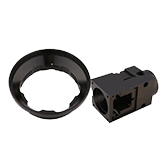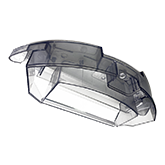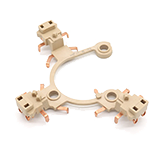Certified Company
Overview: How Injection molding works?
Injection Moldling
CNP’s rapid injection molding process results in an identical set of durable parts for testing and multiple backups. This process has a longer lead time, but it is usually worth it for a product with strict material and mechanical requirements.
The Basics Of Injection Molding Service
Injection molding is one of the most often-used manufacturing processes for creating plastic parts. Thanks to its high-precision, repeatability, and cost efficiency at scale, injection molding is used to make a variety of products and parts from the smallest medical insert up to large automotive & aerospace and defense parts. The injection molding process requires an injection molding machine, raw plastic material, and a machined mold. The raw plastic material is first melted in the injection unit and is then injected into the mold — most often machined from steel or aluminum — where it cools and solidifies into the final plastic part. The key steps in the injection molding process are clamping, injection, cooling, and ejection.
How Injection molding Works
The sequence of events during the injection mould of a plastic part is called the injection molding cycle. The key steps in the injection molding cycle are:
Clamping: The two sides of the mold are closed and clamped shut.
Injection: The material is fed into the machine and pushed towards the mold. While this is happening, the material is melted by heat and pressure. The plastic is then injected into the mold — this is called the “shot.”
Cooling: The plastic in the mold cools and solidifies into the shape of the part.
Ejection: After the part cools, it is ejected from the mold.

Features of Injection Molding Service
Advantages
Drawbacks
Injection Molding Processes
Injection Molding Materials
| Hard Plastics | Flexible Plastics |
|---|---|
| ABS | Acrylonitrile Butadiene Styrene | Polyethylene (PE) |
| ASA | Acrylonitrile Styrene Acrylate | Polystyrene (PS) |
| CA | Cellulose Acetate | PET |
| COPO | Copolyester | EVA Foam |
| PCT | Polycyclohexylenedimethylene Terephthalate | EPS Foam |
| PPA | Polyphthalamide | PU Foam |
| HDPE | High-Density Polyethylene | |
| PEEK |
Rubber-Like Varieties TPE | Thermoplastic Elastomer, Santoprene |
| Polypropylene (PP) | TPU | Thermoplastic Polyurethane (Shore A) |
| Polycarbonate (PC) | LSR | Liquid Silicone Rubber |
| PMMA | Polymethyl Methacrylate, Acrylic | LSR | Liquid Silicone Rubber |
| Nylon 12(PA12) | PVC | Polyvinyl Chloride (Shore A) |
| Nylon 6/66(PA6/66) | POE | Polyolefin Elastomer |
| Derlin (POM) | MPR | Melt Processable Rubber |
| Teflon (PTFE) | EPDM | Ethylene Propylene Diene Monomer Rubber, Viton |
| PBT |
Mixed plastic PC-ABS | Polycarbonate-Acrylonitrile Butadiene Styrene |
| PLA | Polylactic Acid | PC-PBT | Polycarbonate-Polybutylene Terephthalate |
| High-Density Polyethylene (HDPE) | PC-PET | Polycarbonate-Polyethylene Terephthalate |
| PVC | PS-PPE | Polystyrene-Polyphenyl Ethers |
| PPS | Polyphenylene Sulfide, Ryton | PE-PS | Polyethylene-Polystyrene |
| Vespel (PI) | PE-PP | Polyethylene-Polypropylene |
| Torlon 4203 (PAI) | PBT-PET | Polybutylene Terephthalate-Polyethylene Terephthalate |
| UPE/UHMW | PBT-PET | Polybutylene Terephthalate-Polyethylene Terephthalate |
| PVDF | |
| ULTEM (PEI) | |



